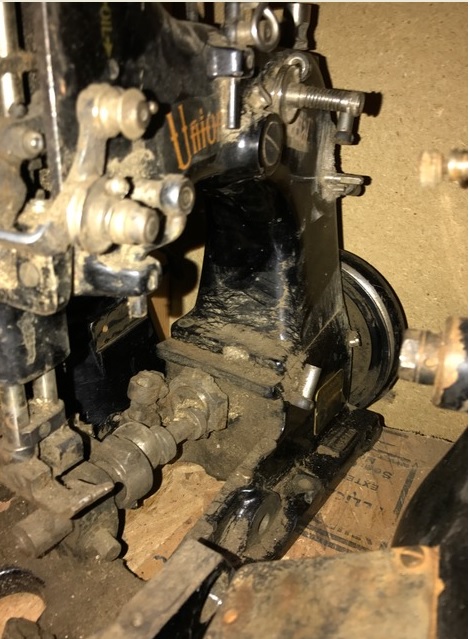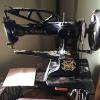-
Content Count
358 -
Joined
-
Last visited
Posts posted by Yetibelle
-
-
Just curious - how much are they asking for it?
-
16 hours ago, Uwe said:Never heard of Apex Tuffmaster before, but it sure looks just like an Adler 220 to me. Casting details are very close to mine, which is less complete and not quite as pretty right now. Perhaps a copy or a importer re-badge job just like Chandler's re-badge of the Adler 67. Might be worth checking out in person. Those machines are wicked heavy and awkward to move - I can barely lift one end of it myself. Don't just plop the head on the concrete floor either - the front end will be resting on fragile hook bits instead of sturdy frame casting parts.)
Uwe --- How many darn machines do you have for cryin-out-loud? HAHA
-
The X box on webbing is just that; the machine is just for making a box with an X in the middle, but that is all it does. This is a special machine for binding the webbing. I sometimes do miss having reverse, but they are great machines, you will enjoy it.
-
Looks like a nice machine. I found the parts PDF for that machine or close enough. I'm not sure what sets the 256 apart from the others? The Servo motor will help with the speed and control, start with that first. Then if its still not slow enough you can add the smaller speed reducer pulley. There are feet for these machines, I assume it came with a standard foot, but you can get a edge-guide foot or a piping foot.
-
Some people get an extra set of feet and then sand the teeth down to an almost smooth finish. This will reduce the mark some leather will mark with any pressure. . You could also try wax paper rather than newspaper.
-
Going from nothing to full speed with a slight press then its probably a pedal issue. Here is the info on the Monster wheel, plus look at the other Learn to Sew videos Sailrite has and if your machine does not have the same speed control as the machines in the videos then you know you have a faulty speed control issue.
-
That is a great build. I like how you kept it low so you can sit and sew at it while its on the wheels. nice work!
-
well that is a really nice machine - I say --- don't be strong -- KEEP IT! If its space you need that machine pops right off the treadle and you can bolt it on the corner of a workbench. You have the hand wheel on there so its all set!
Sorry I have a disorder called OSS ......Old Singer Syndrome.
-
They look more like Electronic Positioning Systems (EPS) attached to clutch motors. They are basic computers that come with a set of pre-programed "sewing macros". So as an example -
start to Sew --- back stich -- sew for 10 inches --back stich --then cut the thread.
They are used to setup repetitive wok. I suspect if you move any of them over they can work on any machine, but it may be hard to figure out how to reprogram them from the setup that may be locked-in.
-
You can get a fancy old cast iron treadle pedal from Ebay cheep and just clamp it on. They would look nice on that old style table.
-
Yeah I have the Singer 221-1, the Singer 319, and a Singer 500a. All old home machines and they can sew canvas and light 2-3 oz leather. It issue I have are those thin needles, and regular thead. Now that I found the heavier threads that is what made me move up to the bigger machines. Yes the walking foot is great, but the 207 thread really looks good in all leather. Haha
i like your 15-91 looks nice!
-
I have the servo on my 111w155 and it's great. I keep it set low most of the time. If you tweek the space correctly betwen the pull-trigger on the motor and the foot petal; when you press with your foot you can get it to crawl one stich at a time. So you extent the down-arm that connects to the petal so it won't allow you get to press full-speed, you can get that slow control. Then as you get more comfortable raise the petal higher and you can get a more speed with a harder press. Just takes a little practice to find the sweet-spot.
If you always want it to crawl then add the extra speed reducer pulley.
-
-
-
7x1 and 7x2 - They are also referred to needles number 794 Groz-Beckert - DYX3 DYX2-LR. some have a round point then the LR leather needles have a sharp point.
So that is the needle system, then you need to pick the size from 19-27. The larger the thread the bigger the needle size, •#92, #138, #207, #277, #346, #415, #554, #624, #690
You can go size 27 with thread #415 - I forgot what I had on the bottom maybe #277?
-
Do you get a "motorcycle" or do you just pony-up and get a HARLEY! I think the machine you have is great, the slight upgrade your going to get from the 1508 is not a Harley, its just another motorcycle. Since you already have a working flat bed get a CB-3200 or CB-4500. ---note the sponsor plug Wiz ---
***Disclaimer*** - I am not affiliated or rewarded for this suggestion, but I am open to the idea....
-
I wanted to try out this method since the parts are easy to get and it installs from the top of the machine.. looks like it works well?
-
I am putting the 29k51 treadle back together tonight after work. I will look and see if they have a part number - or - see what matches from the PDF.
-
Some machines have a sealed pan on the bottom (looks similar to the drip pan) that is filled with oil and the machine has the ability to circulate the oil around the machine, sometimes referred to as "self oiling" machines. Like the Siger 241.
-
Nice find! send pics.
-
Is it an self oil machine? You really don't have to have the drip pan, I don't have them on any machines anymore. But I don't care if my pants get dirty.
-
Ok - Here is my checklist. I typically buy from people who have NO IDEA what they are selling or how to use it so I wont rely on them to tell me if it is working or complete. Sorry grandma the kids only got $50. for your 114w103 because they didn't take the time to look it up.
- Look-up and bring picture examples of the machine your buying; so you can stare and compare the parts. The PDF parts manual helps.
- Search eBay and see how hard parts are to get for that model and the most expensive parts for that model (make sure they aren't missing or they may have extras).
- Look for cracks or damage in the cast-iron - this is a deal breaker unless you know how to smelt-patch-weld cast iron. - I made that last part up.
- Look under the machine, sure they are heavy but tilt it back crawl under (bring flashlight). all the parts under there?
- Bring tools, flashlight, plastic cling wrap, rubber gloves (mouse poop) and a bucket to toss all the loose parts in.
Find and download the pdf manual and parts list. Then go out to eBay and see if there is that same model for sale, take screen captures of the different angels of the machine that they have in the listing and print them out so you can compare them with the sale machine. It's a great puzzle, sometimes you will see a machine run and work in person, yet it is missing a few parts and is being rigged with a coat hanger and vise grips. I bring a flashlight, plastic cling wrap, tools, rubber gloves and a bucket. Once you decided you want to buy it take pictures of the machine from all angles then wrap it up in cling wrap, this way you wont loose parts and it will protect you from the crud (mouse poop). Even if you can load it on a truck standing, its a good ideal to wrap it so the little parts stay put. Plus sometimes the crud is actually a part you really need and you throw it away thinking its crud.
Lets be clear, if all your looking for is a deal, you will be spending numerous hours getting the machine to work "once you think you have got the machine to work". You will find that you are no longer a Leather-Crafter, you are now an Antique Sewing Machine hobbyist (me). So spend a little more money and look for a machine that is in good shape, runs and just needs a servo motor, better yet find one with a servo motor already. Or just save up and get the Cowboy CB4500. You will then be back in the leather crafting business and out of the Sewing Machine restoration business.
Or buy one like this and complete the puzzle. (really how do they get this dirty?)

-
Tricky - I suspect if you can already make a non-leather jacket on a flatbed machine, then you just need a good walking foot machine to sew through the leather. In the video below they appear to make the whole jacket with flatbed machines. Plus I see a few vintage machines in there, I think it all depends on how you design your jacket pattern.
-
Here is the problem, and I don't have a solution. Do you get the machine that fits the "current need" or do you get the machine that fits the "future need" or is "more" capable that what you think you need? What I have noticed is that people like to start with the current need machine and then try push the machine to do more than it is able or recommended to do and then get frustrated. So from that perspective I would spend the extra money (now rather than later) and get the CB4500. You will appreciate the longer arm depth, the larger thread options and the ability to sew through just about anything like butter.



The clutch motor....
in Leather Sewing Machines
Posted · Report reply
Really - get the Servo motor - Clutch motors also use HUGE amounts of electricity to stay spinning, the Servo motor is nice and silent and uses a lot less electricity.
You will not regret it.